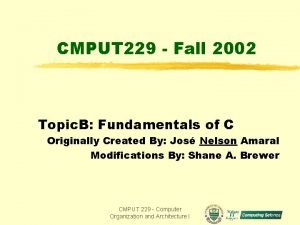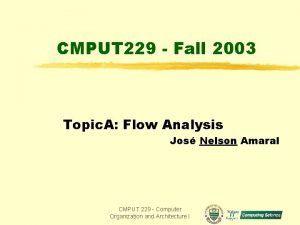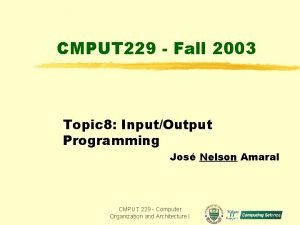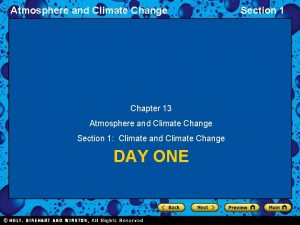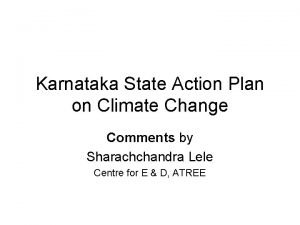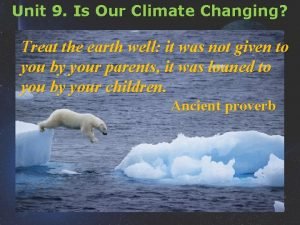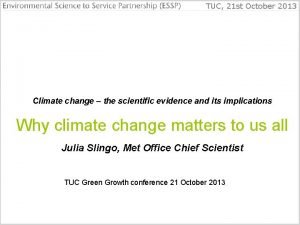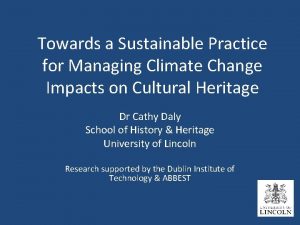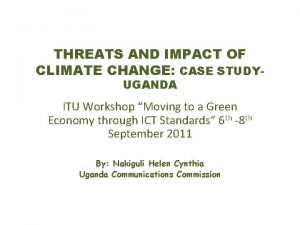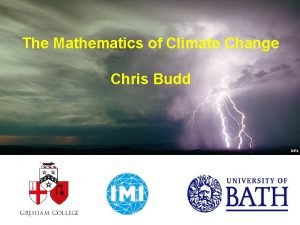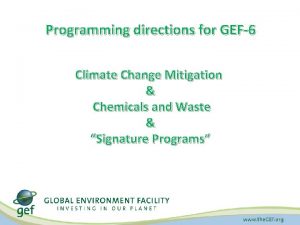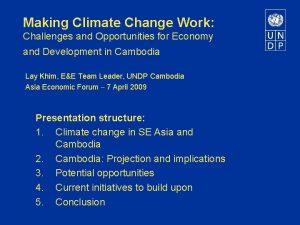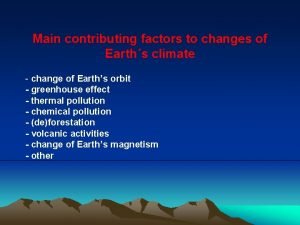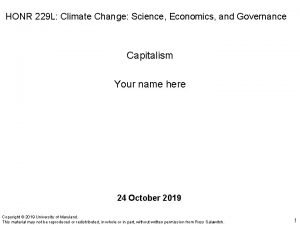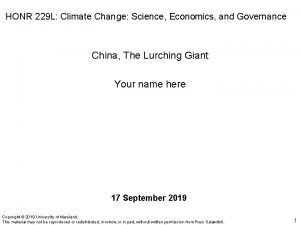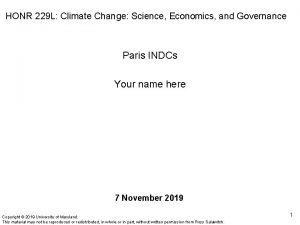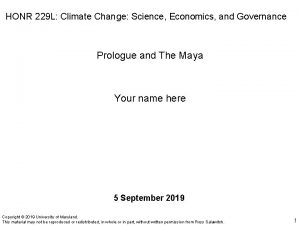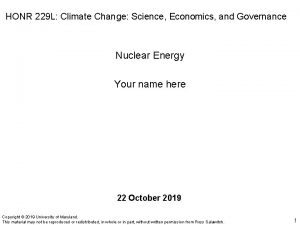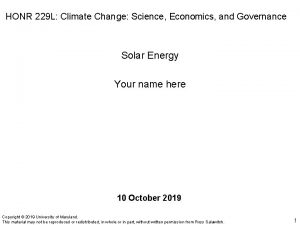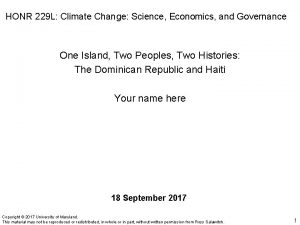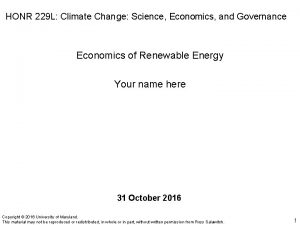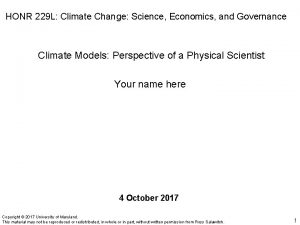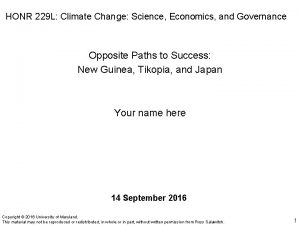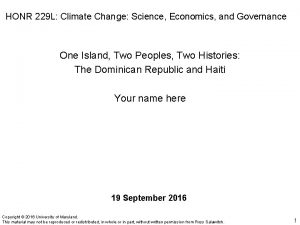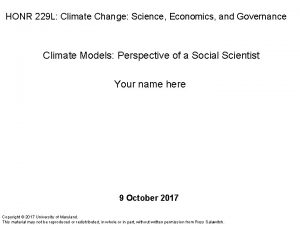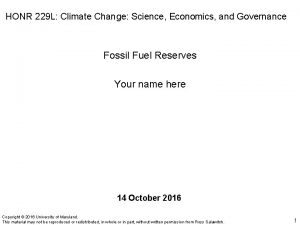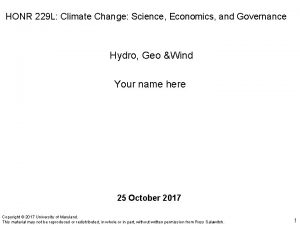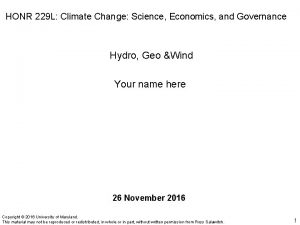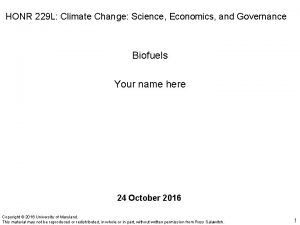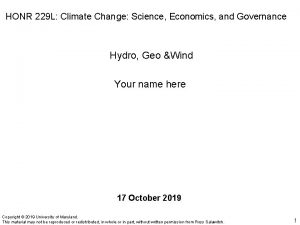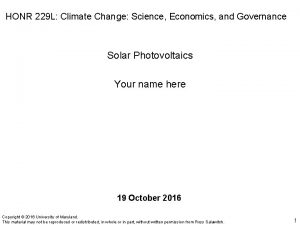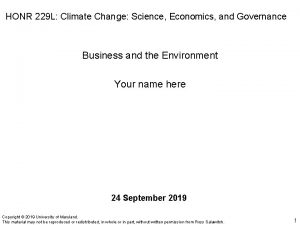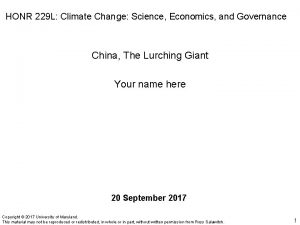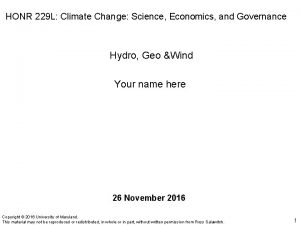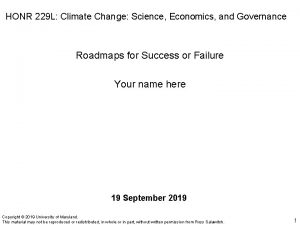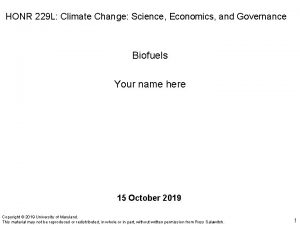HONR 229 L Climate Change Science Economics and

























- Slides: 25

HONR 229 L: Climate Change: Science, Economics, and Governance Climate Models: Perspective of a Social Scientist Your name here 9 October 2017 Copyright © 2017 University of Maryland. This material may not be reproduced or redistributed, in whole or in part, without written permission from Ross Salawitch.

Since this is on the AT, might as well state the two findings from the 1990 IPCC report that Nate Silver describes as being absolutely certain. Then, for each of these findings, you can ask the class to relate the finding to material covered in prior readings! See how much of what I write below the class can articulate! For the first of these findings, that the Greenhouse Effect is real, you can then relate the numerical value Silver gives for how much colder Earth would be without the greenhouse effect (he says Earth would be 0°F or 18°C) to the value given in Table 5. 1 of the Houghton reading (table given on next slide). To do this, you’ll have to actually find the mean temperature of Earth in the appropriate units. Great if the class can recite these numbers … indeed you can ask them to estimate the mean T of Earth. For the second of these findings, you can also walk students through how the statement relates to the prior material. Interesting the book states, page 375, CO 2, CH 4, CFCs, and N 2 O. What gas did we talk about as being an anthropogenic GHG that is left out of this list? The words “water vapor will increase in response to global warming and further enhance it” also certainly ring true with prior material. Copyright © 2017 University of Maryland. This material may not be reproduced or redistributed, in whole or in part, without written permission from Ross Salawitch. 2

Copyright © 2017 University of Maryland. This material may not be reproduced or redistributed, in whole or in part, without written permission from Ross Salawitch. 3

You can then move onto a discussion of the "three prongs" of the critique of IPCC forecasts in the Armstrong and Green paper. The AT asks students to state these three prongs in their own words, then describe one of these in more detail. You can devote a certain amount of time to discussion of each of these three prongs … perhaps asking the class to outline their understanding of the critique, then providing your own spin. When you get to the Uncertainty in Climate Forecasts prong, I suggest you show Figure 12 -3, ask students to describe what the three types of uncertainties mean, ask them why the three types of uncertainties evolve with respect to time in the manner depicted, then ask for some examples of: Scenario uncertainty (note we had shown various future projections of GHGs already, which for your convenience I place on the following slide) Structural uncertainty (IMHO, the sign of the cloud feedback is a huge example here) Copyright © 2017 University of Maryland. This material may not be reproduced or redistributed, in whole or in part, without written permission from Ross Salawitch. 4

Figure 2. 1 Four possible futures for the three most important anthropogenic GHGs Salawitch et al. , Paris Climate Agreement: Beacon of Hope, 2017. Copyright © 2017 University of Maryland. This material may not be reproduced or redistributed, in whole or in part, without written permission from Ross Salawitch.

I did not put this into the AT directly, but I find it fascinating that some of the most outspoken critics of IPCC are TV weathermen. Indeed, this is a bit of a crisis for the American Meteorological Society. You are welcome to conduct your own research on this phenomena, and lead a discussion as to why folks think this is the case. If you go this route, please take careful note of what Silver states are the “two features of their discipline” that have led to improvements in weather forecasts. One is frequent reality check! Another is strong understanding of the physics of weather. FYI, I happen to believe we presently have a stronger understanding of the physics of weather than we have of the physics of climate change . Some would disagree with me. Copyright © 2017 University of Maryland. This material may not be reproduced or redistributed, in whole or in part, without written permission from Ross Salawitch. 6

Consider showing Figure 12 -3 (which is one of the three options for last question of the AT) If you show, ask the students to explain the three sources of uncertainty: i. e. , initial condition (effect on forecast warming diminishes over time) structural uncertainty (dynamics of the climate system, which Silver states might increase slightly over time) scenario uncertainty (i. e. , how will the atmospheric abundance of GHGs change over time). If you show this figure, please note I think Nate Silver grossly mis-represents structural uncertainty. If the climate models do not simulate climate feedback correctly, then the error in forecast global warming could grow over time. Indeed, I think this is what is truly “wrong” with the large climate models. Copyright © 2017 University of Maryland. This material may not be reproduced or redistributed, in whole or in part, without written permission from Ross Salawitch. 7

Consider showing Figure 12 -5 (even though this is not an AT question) This figure shows the global mean surface T anomaly relative to the 1951 to 1980 baseline from 6 data centers. If you show this figure, you might want to ask students to: § define what anomaly means (it is simply the deviation, plus or minus, relative to the average surface T of Earth over 1951 to 1980) § state something remarkable about the plot (I find it remarkable that the data from all 6 centers agree so well) § state something interesting about this plot (I find it interesting that 1998 was such a warm year … something special happened that year … no, not Hansen’s testimony to Congress but rather a huge El Niño event that causes brief warming) Copyright © 2017 University of Maryland. This material may not be reproduced or redistributed, in whole or in part, without written permission from Ross Salawitch. 8

Suggest showing Figure 12 -7 (one of the options for last AT question) Please note the two solid lines in this figure are the upper and lower ends of the IPCC forecast, whereas the line that connects the circles is the actual T Spend some time discussion this figure, as you see fit. In this discussion, I’d appreciate if you could mention: § IPCC originally forecast about 2 to 3°C warming per century, whereas data from 1990 through 2011 suggest a warming of 1. 5°C per century § The next IPCC forecast was for 1. 8°C warming per century Can then ask the class what “grade” they’d give the models § Spoiler alert: when I get up, I will highlight the fact our interpretation of the climate record is that T has actually risen by about 1. 2°C per century (I’m going to state this as 0. 12°C/decade) whereas the most recent IPCC models, from the 2013 report, think the warming should have been about 0. 2 °C/decade (i. e. , the latest climate model projections warm too aggressively, and this is likely due to structural uncertainty in how the cloud feedback is handled. You do not need to discuss anything in this paragraph. Rather, I’m giving you advance notice of what I will state Copyright © 2017 University of Maryland. This material may not be reproduced or redistributed, in whole or in part, without written permission from Ross Salawitch. 9

You could also show Figure 12 -8, since I have stated aerosols are going down: sulfate emissions lead to aerosols, and global emissions of sulfate are declining. If you have time, perhaps you can find an up to date figure of global sulfur emissions, since the plot in the book stops at 2005. Copyright © 2017 University of Maryland. This material may not be reproduced or redistributed, in whole or in part, without written permission from Ross Salawitch. 10

Consider showing Figure 12 -9, and leading a discussion of the merits of “simple” models versus complex models. OK, my group has built a simple climate model, so of course I find inherent value in this approach. On the other hand, most simple climate models only focus on very narrow aspects of the problem …. such as modeling global mean surface T (or perhaps NH & SH T, or perhaps ocean & land T). None of the simple models provide forecasts of precipitation, drought, severe weather. IMHO, even though my group builds simple climate models, there will always be a role for the complex models … because society cares about future forecasts of quantities that can only be provided by the complex models. You’re welcome to use the above PP as you see fit, in a discussion of simple vs complex models. Copyright © 2017 University of Maryland. This material may not be reproduced or redistributed, in whole or in part, without written permission from Ross Salawitch. 11

Figure 12 -11 should be used to engage the class in a discussion of the predictions of Armstrong and Schmidt Your call as to how to, or even whether, to include material on pages 408 to 411 If you should use Figure 12 -11, I suggest pacing the presentation so you can have some discussion, then create a new slide with an update to this image, which you can obtain from: https: //data. giss. nasa. gov/gistemp/graphs_v 3 and then asking the class if they are surprised by the difference in the two figures. Simply put, the recent rise in temperature has been due to: a) a large ENSO event that started in late 2015 b) tendency of climate system to be in a strong La Nina state during the early 2000 s c) a relatively small value of total solar irradiance during the middle part of the time series d) a slight bias in the data, due to closure of some observing stations in the Arctic that is now being corrected in some datasets (not the data in the book, or at GISS) Finally, of course, any 10 year period of time can show deviations from the long term, upward march in global T: neither the figure from the book, or the GISS updates, shakes our view that humans are causing global warming. Copyright © 2017 University of Maryland. This material may not be reproduced or redistributed, in whole or in part, without written permission from Ross Salawitch. 12

Good luck and if you send me an advance copy, I’ll gladly comment. In the next slides I’ll include e-copies of all the figures. No need to use them all … select the ones you think are most important. Copyright © 2017 University of Maryland. This material may not be reproduced or redistributed, in whole or in part, without written permission from Ross Salawitch. 13

Copyright © 2017 University of Maryland. This material may not be reproduced or redistributed, in whole or in part, without written permission from Ross Salawitch. 14

Copyright © 2017 University of Maryland. This material may not be reproduced or redistributed, in whole or in part, without written permission from Ross Salawitch. 15

Copyright © 2017 University of Maryland. This material may not be reproduced or redistributed, in whole or in part, without written permission from Ross Salawitch. 16

Copyright © 2017 University of Maryland. This material may not be reproduced or redistributed, in whole or in part, without written permission from Ross Salawitch. 17

Copyright © 2017 University of Maryland. This material may not be reproduced or redistributed, in whole or in part, without written permission from Ross Salawitch. 18

Copyright © 2017 University of Maryland. This material may not be reproduced or redistributed, in whole or in part, without written permission from Ross Salawitch. 19

Copyright © 2017 University of Maryland. This material may not be reproduced or redistributed, in whole or in part, without written permission from Ross Salawitch. 20

Copyright © 2017 University of Maryland. This material may not be reproduced or redistributed, in whole or in part, without written permission from Ross Salawitch. 21

Copyright © 2017 University of Maryland. This material may not be reproduced or redistributed, in whole or in part, without written permission from Ross Salawitch. 22

Copyright © 2017 University of Maryland. This material may not be reproduced or redistributed, in whole or in part, without written permission from Ross Salawitch. 23

Copyright © 2017 University of Maryland. This material may not be reproduced or redistributed, in whole or in part, without written permission from Ross Salawitch. 24

Copyright © 2017 University of Maryland. This material may not be reproduced or redistributed, in whole or in part, without written permission from Ross Salawitch. 25
 Climate change 2014 mitigation of climate change
Climate change 2014 mitigation of climate change Cmput 229
Cmput 229 Mark rouleau
Mark rouleau Cmput 229
Cmput 229 Cmput 229
Cmput 229 Iz 229
Iz 229 Maastricht university school of business and economics
Maastricht university school of business and economics Climate change meaning
Climate change meaning Chapter 13 atmosphere and climate change section 1
Chapter 13 atmosphere and climate change section 1 Chapter 13 atmosphere and climate change
Chapter 13 atmosphere and climate change What was your favorite subject as a child
What was your favorite subject as a child Econ213
Econ213 Persuasive essay about global warming
Persuasive essay about global warming Karnataka state action plan on climate change
Karnataka state action plan on climate change How many major climate types are there worldwide brainpop
How many major climate types are there worldwide brainpop Unit 9 climate change
Unit 9 climate change Conclusion of climate change
Conclusion of climate change Youreuropemap.com
Youreuropemap.com Conclusion of climate change
Conclusion of climate change Mathematics of climate change
Mathematics of climate change Globalization definition ap world history
Globalization definition ap world history Climate change mitigation
Climate change mitigation Pc 414
Pc 414 Conclusion of climate change
Conclusion of climate change Factors of climate change
Factors of climate change Conclusion of climate change
Conclusion of climate change

